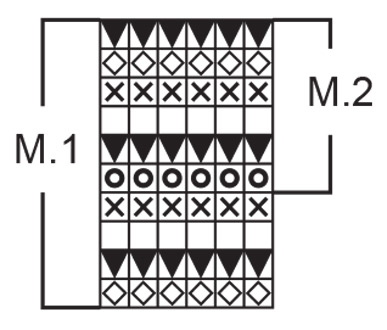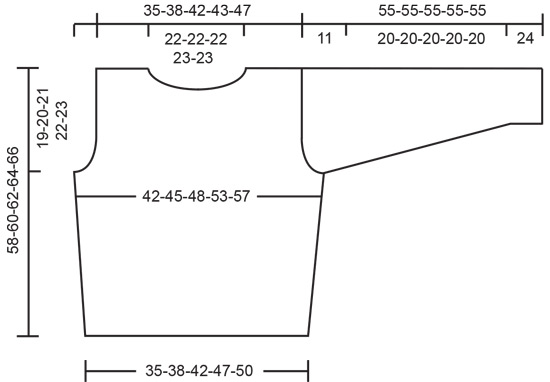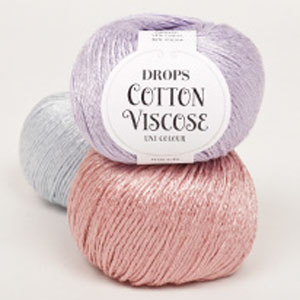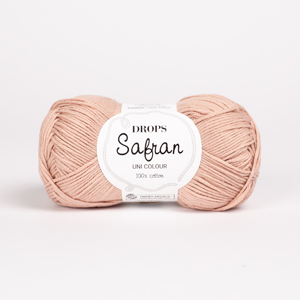Comments / Questions (18)
Theresa wrote:
What is Pattern 1 and Pattern 2? Where are the instructions for them?
18.07.2018 - 15:02DROPS Design answered:
Dear Theresa, sure there are, Pattern 1 and Pattern 2 are diagram M.1 and M.2 - start reading the diagram from the bottom corner on the right side from RS towards the left (and left towards right from WS), you'll find the key to diagram just above measurement chart/diagram. Happy knitting!
18.07.2018 - 15:22Debbie Bland wrote:
Hi, sorry me again! I'm knitting the last back piece, do I include the 23 centre stitches in my rows with the shoulders or do I leave them on the needle and only knit the 5 stitches as the front ? Also do I sew the seams with all seven strands or can I use less? Wish it was happy knitting!! Kind regards
19.01.2016 - 09:19DROPS Design answered:
Dear Mrs Bland, on back piece, you bind the remaining sts on sleeve as you did for front piece, while bind off the mid 13 sts for neck (finish then each shoulder separately). Sewing with all threads may help that seams are not too tight. Happy knitting!
19.01.2016 - 10:17Debbie Bland wrote:
I don't seem to be able to work out how to knit the neck & shoulders starting from the front section after the yolk. I'm also confused with the knitting tip -2. I've got all my stitches on the correct holders so do I start left side of front when facing you? Spent hours trying to work it out as I don't want to make a mistake at this stage with all the strands of yarn!
13.01.2016 - 17:11DROPS Design answered:
Dear Mrs Bland, you finish each side of front piece separetely, dec for neck towards mid front and at the same time, on right shoulder (when worn), dec as under knitting tip-2 from RS: at the end of row: work the sts on back piece, and dec the sts for sleeves, from WS: at beg of row, slip 1 st from st holder back on to needle and P tog this st with 1st st on front piece. - reversed for the 2nd side of front piece. Happy knitting!
13.01.2016 - 17:19
![]() GARIN STEPHANIE wrote:
GARIN STEPHANIE wrote:
Bonjour la reponse n'a pas été apporter à la question pour l'empiecement dans quel ordre doit-on mettre les morceaux dos devant et manches ?
26.04.2015 - 15:38DROPS Design answered:
Bonjour Mme Garin, vous pouvez commencer au milieu dos ou par un des raglans au dos, par ex: mailles du dos, 1ère manche, devant, 2ème manche. Bon tricot!
27.04.2015 - 11:21
![]() Agnes wrote:
Agnes wrote:
Een mooi patroon maar de lengte maten kloppen niet er zit 10 cm verschil in met het orginele patroon als je het nederlandse patroon volgt wordt deze prachtige trui 10 cm tekort dat is toch wel zonde.
22.09.2013 - 21:11DROPS Design answered:
Hoi Agnes. Je hebt gelijk. De vertaling is helaas verkeerd. Ik heb het patroon nu aangepast. Bedankt voor het melden!
02.10.2013 - 16:11
![]() Phosphore wrote:
Phosphore wrote:
Bonjour, Je souhaite tricoter ce modèle, mais j'aurais quelques questions. Quelle longueur d'aiguilles circulaires n°15 conseillez vous ? 60, 80 ou 100 cm ? Pour l'empiècement, dans quel ordre met on les manches le dos et le devant ? Et ensuite doit on tricoter avec le même fils en rond ou en aller retour ? Merci pour votre réponse car je suis un peu perdue.
28.06.2012 - 09:37DROPS Design answered:
Bonjour Phosphore, le dos, les devants et les manches se tricotent en allers retours, seul l'empiècement se tricote en rond. Une aiguille circulaire de 60 ou 80 cm suffira. Pour toute aide personnalisée, n'hésitez pas à contacter votre détaillant Drops ou à demander de l'aide sur le forum DROPS. Bon tricot !
28.06.2012 - 13:16
![]() Drops Design wrote:
Drops Design wrote:
Bonjour Bonzom, la qualité et les quantités requises sont indiquées à droite de photo soit : Qualité Drops Coton Viscose : 100-100-150-150-150 g de chacun des coloris suivant : n°4, moutarde, n°10 vert mousse, n° 11 kaki Qualité Drops Safran : 100 g pour toutes les tailles dans les coloris suivants : n°14 olive, n° 28 orange, n° 31 pistache et n°32 rose/vert bigarré et Aiguille circulaire Drops n° 15, + ou – grosse pour obtenir l’échantillon Bon tricot !
29.06.2009 - 09:06
![]() Bonzom wrote:
Bonzom wrote:
Bonjour, je voudrais savoir la quantité de laine et laquelle il me faut pour réaliser ce pull?merci,cordialement.
28.06.2009 - 13:46
DROPS 82-13 |
||||||||||||||||
|
|
||||||||||||||||
DROPS Pullover in Cotton-Viscose and Safran.
DROPS 82-13 |
||||||||||||||||
|
Gauge: 6 sts x 8 rows with 7 strands in stockinette st = 10 x 10 cm. Pattern: See chart. Knitting tips-1 (for yoke shaping): Dec 1 st as follows after the marker: K 2 tog. Dec 1 st as follows before the marker: Slip 1 st as if to knit, K 1, psso. Knitting tips-2 (for sleeve cap shaping): Dec 1 st from sleeve cap sts on st holder as follows: From right side: At the beginning of the row: put 1 st from st holder back on the needle and K 2 tog (the sleeve cap st and the first st on the needle from front or back). At the end of the row: Slip the last st on the row as if to knit, K 1 st from st holder, and psso. From wrong side: At the beginning of the row: slip the 1st st from needle, then twist and return to left needle, twist and put 1 st from st holder onto left needle, then P 2 tog. At the end of the row: P 2 tog. Knitting tip: Because you are working with so many strands of yarn together, take extra care to not drop any of them while putting them onto or taking them off of st holders. Measuring-tips: On account of the pattern and weight of the garment, make all measurements when the piece is held up, otherwise it will be too long when worn. --------------------------------------------- FRONT Work back and forth on circular needle. Loosely cast on 21-23-25-28-30 sts with 1 strand of each color (= 7 strands). Knit 2 rows garter st (row 1 = right side), then knit Pattern 1 one time in height - AT THE SAME TIME when piece measures 7 cm and 14 cm/ 2¾" and 5½" inc 1 st each side = 25-27-29-32-34 sts. After Pattern 1 the piece measures approx. 22 cm/8¾". Change to stockinette st. When the piece measures 39-40-41-42-43 cm/15¼"-15¾"-16"-16½"-17" bind off 2 sts at each side for armhole = 21-23-25-28-30 sts remain. Lay piece aside and knit Back. BACK Cast on and knit the same as the front. Lay piece aside and knit the sleeves. SLEEVE Loosely cast on 14-14-14-16-16 sts with 1 strand of each color (= 7 strands). Knit 2 rows garter st (row 1 = right side), then knit Pattern 2 one time, then change to stockinette st. When the piece measures 24 cm inc 1 st at each side every 6 cm a total of 4 times = 22-22-22-24-24 sts. When the piece measures 44 cm – read Measuring-tips – bind off 2 sts at each side = 18-18-18-20-20 sts remain. Lay piece aside and knit second sleeve. YOKE Put the sleeves in on the same circular needles as Body where you bound off for armhole = 78-82-86-96-100 sts. Put a marker in each transition between front, back and sleeves. Knit 1 round decreasing 1 st at each side of each sleeve in all sizes and 1 st at each side of Body in sizes XL and XXL only – see knitting tips-1. Knit 1 round over all sts. On the next round dec 1 st at each side of each sleeve 1 time = 70-74-78-84-88 sts. Knit the next round as follows: * K 1, 2 yo on needle *, repeat from * - *. On the next round let yo loops drop and dec 1 st at each side of each sleeve again – see knitting tips-1 = 66-70-74-80-84 sts. Knit stockinette st over all sts until the piece measures 50-52-54-56-58 cm at center front. Now put the 12-12-12-14-14 remaining sts of each sleeve on st holders and the center front 9-9-9-10-10 sts on another st holder for the neck. Knit the front and back separately. Read the entire next section before knitting: FRONT Read all section before continuing. Neckband: Dec 1 st at each neck edge every other row 2 times. Sleeve cap: At the same time dec 1 st from sleeve sts – see knitting tips-2 – at front side of sleeve cap every row 6-6-6-7-7 times – when you make the last dec, also bind off the remaining 4-5-6-6-7 shoulder sts. You will still have 6-6-6-7-7 sleeve cap sts on the st holder.When all front sts are bound off the piece measures approx. 58-60-62-64-66 cm. BACK = 21-23-25-26-28 sts. Bind off the remaining 6-6-6-7-7 sts on sleeve cap as on front. When the piece measures 56-58-60-62-64 cm bind off the center 13-13-13-14-14 sts for the neck. Bind off shoulder sts as on front. ASSEMBLY Sew sleeve and side seams. Be sure the seams are not too tight. Sew opening under the sleeve. Sew right shoulder. Neckband: Pick up approx. 30-35 sts around the neck on circular needles with 1 strand of each color (= 7 strands). Knit 1 row knit from wrong side, and then bind off. Sew left shoulder and up along neckband. |
||||||||||||||||
Diagram explanations |
||||||||||||||||
|
||||||||||||||||
 |
||||||||||||||||
 |
||||||||||||||||
Have you finished this pattern?Tag your pictures with #dropspattern or submit them to the #dropsfan gallery. Do you need help with this pattern?You'll find 19 tutorial videos, a Comments/Questions area and more by visiting the pattern on garnstudio.com. © 1982-2025 DROPS Design A/S. We reserve all rights. This document, including all its sub-sections, has copyrights. Read more about what you can do with our patterns at the bottom of each pattern on our site. |
||||||||||||||||

























































Post a comment to pattern DROPS 82-13
We would love to hear what you have to say about this pattern!
If you want to leave a question, please make sure you select the correct category in the form below, to speed up the answering process. Required fields are marked *.